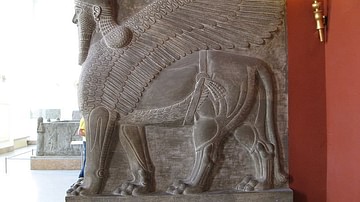
Semiramis is a legendary queen thought to based on the historical Sammu-Ramat (r. 811-806 BCE) the queen regent of the Assyrian Empire who held the throne for her young son Adad Nirari III until he reached maturity. She is also known as Shammuramat or Sammuramat. She is referenced by several ancient historians including Herodotus, Diodorus Siculus, and Plutarch.
She was the wife of Shamshi-Adad V (r. 823-811 BCE) and, when he died, she assumed rule until Adad Nirari III came of age, at which time she passed the throne to him. According to scholar Gwendolyn Leick, “This woman achieved remarkable fame and power in her lifetime and beyond. According to contemporary records, she had considerable influence at the Assyrian court” (155). This would explain how she was able to maintain the throne after her husband's death. Women were not admitted to positions of authority in the Assyrian Empire, and to have a woman ruler would have been unthinkable unless that particular woman had enough power to take and hold it.
This, however, is precisely the problem with Sammu-Ramat's reign: there is very little information about what she did and how she went about doing it and some scholars refer to her simply as “an obscure Assyrian lady of the eighth century B.C. of whom we know nothing for certain except that she is named on an inscription as lady of the palace” (rbedrosian.com, 2). It would seem, however, that she was much more than that and, however little may be left to record her reign, there is enough to suggest that she was the equal of her predecessors and secured the kingdom after the death of her husband.
Semiramis' Ancestry
Shamshi-Adad V was the son of King Shalmaneser III (r. 859-824 BCE) and grandson of Ashurnasirpal II (r. 884-859 BCE). Their successful reigns and military campaigns would have provided Shamshi-Adad V with the stability and resources to begin his own successful reign had it not been for the rebellion of his older brother.
Shalmaneser III's elder son, Ashur-danin-pal, apparently grew tired of waiting for the throne and launched a revolt against Shalmaneser III in 826 BCE. Shamshi-Adad V took his father's side and crushed the rebellion, but this took him six years to accomplish. By the time Ashur-danin-pal was defeated, much of the resources which Shamshi-Adad V would have had at his disposal were gone, and the Assyrian Empire was weakened and unstable.
Semiramis' Reign
It is at this time that Sammu-Ramat appears in the historical record. It is not known what year she married the king, but when her husband died and she took the throne, she was able to provide the nation with the stability it needed. Historians have speculated that, since the times seemed so uncertain to the people of Assyria, the successful reign of a woman would have engendered a kind of awe greater than that of a king because so unprecedented. She was powerful enough to have her own obelisk inscribed and placed in prominence in the city of Ashur. It read:
Stele of Sammuramat, queen of Shamshi-Adad, King of the Universe, King of Assyria, Mother of Adad Nirari, King of the Universe, King of Assyria, Daughter-in-Law of Shalmaneser, King of the Four Regions of the World.
What exactly Sammu-Ramat did during her reign is unknown, but it seems she initiated a number of building projects and may have personally led military campaigns. Scholar Stephen Bertman sums up most, if not all, that is known of her reign in a single paragraph:
Semiramis (Sammuramat) was the wife of Shamshi-Adad V and the mother of his successor, Adad Nirari III. She took the extraordinary step of accompanying her husband on at least one military campaign, and she is prominently mentioned in royal inscriptions. Thanks to embellishments added to her biography by later Greek historians, she became the most famous queen of Assyria, legendary for her beauty, cruelty, and sexual appetite. (102)
The "embellishments" of the later historians have obscured the historical figure significantly so that it is difficult, except in the most extreme instances, to separate legend from fact. It seems that, after the death of her husband she continued to lead military campaigns herself although this claim, like those concerning much of her reign, has been challenged.
Whatever she did, it stabilized the empire after the civil war and provided her son with a sizeable and secure nation when he came to the throne. It is known that she defeated the Medes and annexed their territory, may have conquered the Armenians and, according to Herodotus, may have built the embankments at Babylon on the Euphrates River which were still famous in his time. What else she did, however, merged with myth in the years after her reign. The historian Susan Wise Bauer comments on this, writing:
The Babylonian princess Sammu-Ramat stepped into the place of power. A woman on the Assyrian throne: it had never been done before, and Sammu-Ramat knew it. The stele she built for herself is at some pains to link her to every available Assyrian king. She is called not only queen of Shamshi-Adad and mother of Adad-Nirari, but also “daughter-in-law of Shalmaneser, king of the four regions.” Sammu-Ramat's hold on power was so striking that it echoed into the distant historical memory of a people just arriving on the scene. The Greeks remembered her, giving her the Greek name Semiramis. The Greek historian Ctesias says that she was the daughter of a fish-goddess, raised by doves, who married the king of Assyria and gave birth to a son called Ninyas. When her husband died, Semiramis treacherously claimed his throne. The ancient story preserves an echo of Adad-Nirari's name in Ninyas, the son of the legendary queen; and it is not the only story to hint that Sammu-Ramat seized power in a manner not exactly aboveboard. Another Greek historian, Diodorus, tells us Semiramis convinced her husband to give her power just for five days, to see how well she could manage it. When he agreed, she had him executed and seized the crown for good. (349)
These legends concerning Semiramis and her marriage to Ninyas (also known as Ninus) inspired still more tales of the queen's reign. According to the Gesta Treverorum (12th century CE), an account of the Germanic Treveri tribe, Semiramis even exerted influence over ancient Germania. According to the story, Ninyas had a son by an earlier marriage named Trebeta. Semiramis hated her stepson and saw him as a threat. After Ninus' death, she either exiled him or he, fearing for his life, left Assyria with a band of followers and eventually founded the city of Trier, which would become one of the largest cities in the Roman Empire.
Other ancient accounts, such as those by Diodorus Siculus, also seem to have combined earlier accounts of Sammu-Ramat's reign with myths and legends relating to the goddess Astarte and Ishtar/Inanna so that, in time, the historical queen became the mythical, semi-divine, Semiramis. This theory is contested, however, and there are those historians who claim Sammu-Ramat had nothing to do with the later figure of Semiramis and even those who claim that Sammu-Ramat never ruled as regent.
The historian Wolfram von Soden, to cite only one example, writes, “That Sammu-Ramat, the Semiramis of Greek literature, was temporarily regent after 810 BCE cannot, however, be proven” (67). Von Soden is not alone in this opinion but other historians, such as Bauer, are just as adamant in their claims that Sammu-Ramat not only reigned over the Assyrian Empire but was the inspiration for the myths and legends surrounding Semiramis.
Semiramis in Literature
She remains, therefore, one of the more controversial figures from ancient history and has become more so since the 19th century CE when the Christian minister Alexander Hislop published his book The Two Babylons (originally in 1853 CE and a more popular edition in 1858 CE), linking Semiramis with the whore of Babylon from the biblical Book of Revelation, Chapter 17. Even though The Two Babylons is clearly anti-Catholic propaganda and has no claim to biblical or historical accuracy, it is still cited by certain protestant Christian works as an authority on the subject, and the book therefore contributes to the controversy surrounding Semiramis.
The book claims, to cite only two examples of biblical inaccuracy, that Semiramis was Nimrod's wife, whereas Chapter 10 of Genesis says no such thing, and famously insists that Semiramis is the whore of Babylon when her name is nowhere mentioned in the Bible. The historical inaccuracies in the work are too numerous to mention. Even so, the book continues to exert a powerful influence over certain readers and their understanding of ancient history in general and Semiramis specifically.
Whether Sammu-Ramat was the model for Semiramis continues to be argued by modern historians, who often cite the same ancient inscriptions for their conflicting arguments, and it does not seem to be a debate that will be settled anytime soon. Based simply on the evidence of Sammu-Ramat being able to erect her own stele at the prestigious city of Ashur, however, it would appear she was a very impressive and very powerful Assyrian queen who was known to later generations as Semiramis.











